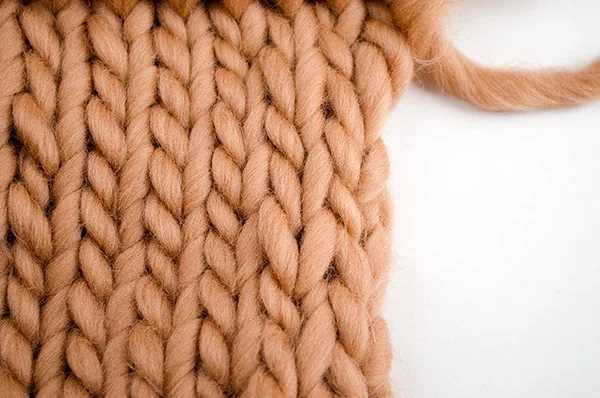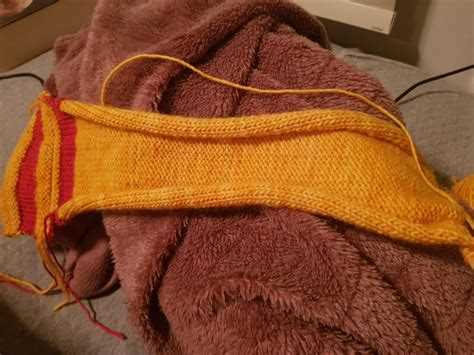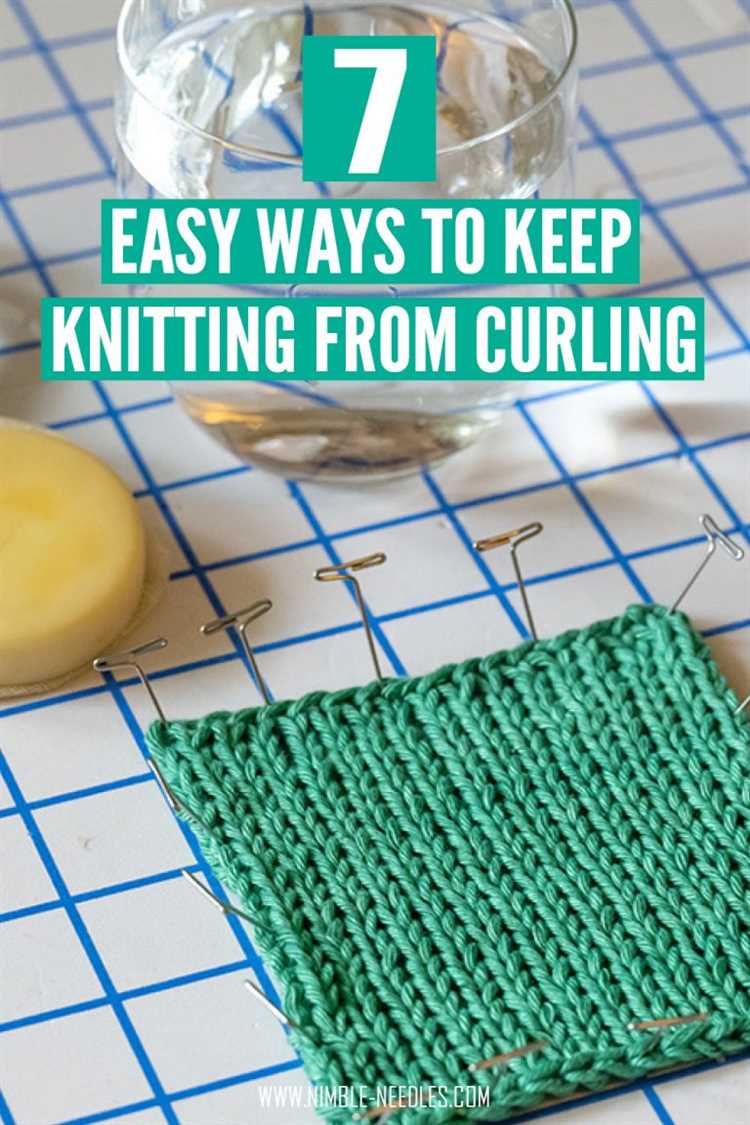Knitting is a relaxing and enjoyable craft that allows you to create beautiful and cozy garments and accessories. However, one common frustration that many knitters face is curling in their finished projects. Curling occurs when the edges of a knitted piece roll inward, creating an undesired shape and making the item difficult to wear or use.
If you’ve ever experienced curling in your knitting projects, don’t worry! There are several simple tips and techniques that can help prevent curling and ensure that your finished pieces lay flat and look professional. In this article, we’ll explore five effective methods to combat curling and achieve the desired shape and drape in your knitting projects.
1. Use the Right Yarn
The choice of yarn can greatly affect the curling tendency of your knitting projects. Opt for yarns that have a good amount of weight and natural drape, such as wool or cotton blends. These fibers have more stability and will help your knitted fabric lay flat. Avoid using yarns with high elasticity, like acrylic, as they tend to retain their shape and encourage curling.
2. Adjust Your Gauge
Another factor that contributes to curling is the tension or gauge of your knitting. If you’re using needles that are too small for your yarn or knitting tightly, it can cause the fabric to curl. Experiment with different needle sizes to achieve the correct gauge specified in your pattern. Taking the time to swatch and block your knitting will also help you determine the optimal gauge and prevent curling.
Understanding Curling in Knitting Projects
When knitting projects curl, it can be frustrating and disappointing. Understanding why this happens can help you prevent it and achieve flat, professional-looking results. Here are some key factors that contribute to curling in knitting projects:
- Type of stitch: Certain stitches, such as stockinette stitch, have a natural tendency to curl. This is because the knit stitches on one side are flatter and wider than the purl stitches on the other side, causing the fabric to curl towards the flatter side.
- Tension: Uneven tension in your knitting can also cause curling. If your tension is looser on the edges than in the center, the edges will contract and curl. It is important to maintain consistent tension throughout your project to prevent curling.
- Yarn choice: Some types of yarn are more prone to curling than others. Yarns with a high percentage of animal fibers, like wool, tend to curl more due to their natural elasticity. Additionally, yarns with little to no drape can contribute to curling.
- Needle size: The size of your knitting needles can affect curling. Using larger needles than recommended for your yarn can result in a looser fabric that is more likely to curl. Conversely, using smaller needles can create a tighter fabric that is less likely to curl.
- Blocking: Blocking your finished project can help reduce curling. Wet blocking involves soaking your knitting in water, gently pressing out the excess moisture, and then laying it flat to dry. This can help relax the fibers and reshape the fabric to reduce curling.
By understanding these factors and taking preventive measures, you can minimize or eliminate curling in your knitting projects. Experimenting with different stitch patterns, yarns, needle sizes, and blocking methods can help you achieve the desired results and create beautifully flat knitted pieces.
Choose the Right Yarn
When it comes to preventing curling in knitting projects, choosing the right yarn can make all the difference. Certain yarn fibers have greater natural elasticity and drape, which can help minimize curling. Here are some factors to consider when selecting yarn for your knitting project:
- Fiber Content: Look for yarns with a higher percentage of natural fibers like wool or alpaca. These fibers have more elasticity and weight, which can help counteract curling tendencies.
- Blends: Blended yarns can also be a good choice. For example, a yarn with a mix of wool and nylon can provide more structure and stability to your project, reducing the chances of curling.
- Weight: Consider the weight of the yarn. Thicker yarns, such as bulky or chunky weight, tend to provide more anchoring and less curling than thinner yarns like lace or fingering weight.
- Ply: Yarns with multiple plies can be more stable and less prone to curling. Look for yarns with more plies, such as 3 or 4-ply, for added stability.
- Texture: Smooth yarns without a lot of texture can help prevent curling. Yarns with a tight twist or a smooth surface will be less likely to curl compared to loosely spun or textured yarns.
By choosing the right yarn for your knitting project, you can minimize curling and create a finished piece that lies flat and looks professional. Consider the fiber content, blends, weight, ply, and texture of the yarn to make an informed choice.
Use the Right Knitting Needles
Choosing the right knitting needles can make a significant difference in preventing curling in your knitting projects. The type and size of needles you use can affect the tension and stitch formation, which can ultimately influence the curling of your knitted fabric.
1. Needle Material: Different needle materials have varying levels of grip on the yarn. Needles made of metal or bamboo tend to have a smoother surface, which can result in the yarn slipping more easily. On the other hand, needles made of wood or plastic have a bit more grip, preventing the yarn from sliding too much. Consider using needles with a bit of texture to help keep the stitches in place.
2. Needle Size: The size of the needles you choose can also impact the curling of your fabric. Thicker needles tend to create looser stitches, while smaller needles create tighter stitches. If your project is prone to curling, try using smaller needles to create a denser fabric that is less likely to curl.
3. Needle Type: The type of knitting needles can affect the tension and stretchiness of your fabric. Straight needles create a tension that can cause curling, especially when combined with the wrong yarn. Circular or double-pointed needles distribute the weight of the project more evenly, reducing the likelihood of curling.
4. Needle Length: The length of the needle can also impact curling. Longer needles allow for more stitches to be held, spreading the weight across a larger area. This can help reduce curling by creating a more even tension throughout the project.
5. Experiment and Adjust: Every knitting project is unique, so don’t be afraid to experiment with different needle materials, sizes, and types. If you find that your project is still curling despite using the “right” needles, try adjusting your tension or blocking the finished piece to minimize the curl. Remember, knitting is a versatile craft, and finding the perfect combination of needles and techniques may require some trial and error.
Apply Blocking Techniques
Blocking is an essential step in preventing curling in knitting projects. It involves shaping and setting the finished piece using moisture and heat. Here are some blocking techniques that can help you prevent curling:
- 1. Wet Blocking: Soak your knitted piece in lukewarm water with a gentle detergent for about 20 minutes. Gently squeeze out the excess water and lay it flat on a towel. Shape the piece to the desired dimensions and pin it in place. Allow it to dry completely before unpinning.
- 2. Steam Blocking: Use a steam iron or a handheld steamer to apply steam to your knitted piece. Hold the iron or steamer a few inches above the fabric and move it in a sweeping motion to evenly distribute the steam. Gently shape the piece and pin it in place. Allow it to dry completely before unpinning.
- 3. Reblocking: If your knitted piece starts to curl again after blocking, you can reblock it to correct the issue. Simply repeat the blocking process, making sure to shape the piece carefully and allow it to dry completely.
- 4. Spray Blocking: Fill a spray bottle with water and lightly mist your knitted piece. Gently shape the piece and pin it in place. Allow it to dry completely before unpinning.
- 5. Combination Blocking: Sometimes a combination of wet blocking and steam blocking can be effective in preventing curling. You can start with wet blocking, and once the piece is nearly dry, use a steam iron or steamer to apply additional heat and shape the fabric.
By applying these blocking techniques, you can enhance the overall appearance of your knitted projects and prevent unwanted curling.
Incorporate Ribbing or Garter Stitch
One of the best ways to prevent curling in your knitting projects is to incorporate ribbing or garter stitch into your design. These stitch patterns create a natural edge that helps to counteract the curling tendency of stockinette stitch.
Ribbing involves alternating knit and purl stitches in a regular pattern. The most common ribbing pattern is K1, P1, where you knit one stitch and purl one stitch across the row. This creates a stretchy and textured fabric that lays flat and helps to prevent curling.
Garter stitch, on the other hand, is created by knitting every row. This stitch pattern creates ridges of knit stitches on both sides of the fabric, which adds stability and prevents curling. It is often used for borders or as an accent in knitting projects.
When incorporating ribbing or garter stitch into your design, you can use them as a border or as a section within your project. For example, you can start and end your project with a few rows of ribbing or garter stitch, or you can add a ribbed or garter stitch edging to a scarf or blanket.
Additionally, you can use ribbing or garter stitch in combination with other stitch patterns to create interesting textures and patterns while still preventing curling. Experiment with different combinations to find the best solution for your specific project.
| Advantages | Explanation |
|---|---|
| Prevents Curling | Ribbing and garter stitch create natural edges that counteract the curling tendency of stockinette stitch. |
| Provides Stability | The alternating knit and purl stitches in ribbing and the ridges in garter stitch add stability to the fabric, preventing curling. |
| Allows for Design Versatility | Ribbing and garter stitch can be used as borders or sections within a project, or in combination with other stitch patterns to create interesting textures. |
Follow Proper Tension
Proper tension is essential in preventing curling in your knitting projects. Tension refers to how tightly or loosely you knit your stitches. If your tension is too tight, your knitting will be stiff and less likely to curl. On the other hand, if your tension is too loose, your knitting may become floppy and more prone to curling.
To achieve the proper tension, always make sure to follow the recommended gauge specified in your knitting pattern. Use the recommended needle size and yarn weight to achieve the correct tension.
When knitting, try to maintain a consistent tension throughout your project. Avoid pulling the yarn too tightly when forming your stitches, as this can lead to tight knitting and curling. Likewise, be mindful not to knit too loosely, as this will result in a less stable fabric that is more susceptible to curling.
It may be helpful to periodically check your tension as you work. Take a moment to measure your gauge using a ruler or a designated gauge swatch. If your tension is off, adjust your knitting technique accordingly.
Additionally, different stitch patterns can affect the tension of your knitting. Some stitch patterns naturally produce tighter or looser fabric. Be aware of how the stitch pattern you choose for your project may impact its tendency to curl. If you’re concerned about curling, consider using a stitch pattern that is known for producing a flatter result.
Following proper tension guidelines will help you create a well-balanced fabric that is less likely to curl. By paying attention to your tension and choosing stitch patterns wisely, you can ensure that your knitting projects lay flat and look their best.
FAQ:
Why does my knitting project keep curling?
There are a few reasons why your knitting project may be curling. One reason is that the stitch pattern you are using has a natural curl to it. Another reason is that the tension of your knitting may be too tight. Additionally, using yarn that is prone to curling, such as acrylic, can also cause your project to curl. To prevent curling, you can try blocking your project or using different stitch patterns that are less likely to curl.
What can I do to prevent curling in my knitting projects?
There are several tips you can follow to prevent curling in your knitting projects. First, you can try changing your stitch pattern to one that is less likely to curl. Ribbing or garter stitch are good options. Second, you can block your project after you finish knitting it. This involves wetting the project and then gently stretching it to the desired shape and size. Third, you can use a different type of yarn that is less prone to curling, such as wool. Finally, make sure you are not knitting too tightly, as tight tension can contribute to curling.
Will using a different type of yarn prevent curling?
Using a different type of yarn can help prevent curling in your knitting projects. Yarns that are made of natural fibers, such as wool or cotton, are generally less prone to curling than synthetic fibers like acrylic. Natural fibers have more memory and are more elastic, which can help prevent curling. If you find that your project is still curling even with a different type of yarn, you can try blocking it or changing your stitch pattern to one that is less likely to curl.
How do I know if my tension is too tight?
If your knitting project is curling, it may be a sign that your tension is too tight. When you knit with tight tension, it can cause the stitches to pull in and create a curling effect. To check if your tension is too tight, you can compare your knitting to a gauge swatch or a pattern. If your stitches are significantly smaller than the recommended gauge, then your tension is likely too tight. To prevent curling, try knitting with a looser tension and see if that helps.
Is there a specific stitch pattern that is less likely to curl?
Yes, there are certain stitch patterns that are less likely to curl than others. The most common stitch patterns that prevent curling are ribbing and garter stitch. Ribbing, which alternates knit and purl stitches, creates a fabric that lays flat and is less prone to curling. Garter stitch, which consists of knitting every row, also produces a flat fabric that is less likely to curl. If you are struggling with curling in your knitting projects, try using one of these stitch patterns and see if it helps.
What is blocking and how does it prevent curling?
Blocking is a process in which you wet your finished knitting project and then shape it to the desired dimensions. This helps to relax the fibers and set the stitches in place. Blocking can prevent curling in your knitting projects by stretching out the edges and ensuring that the fabric lays flat. It can also help to even out any irregularities in your knitting. After blocking, your project should maintain its shape and size, reducing the likelihood of curling.


